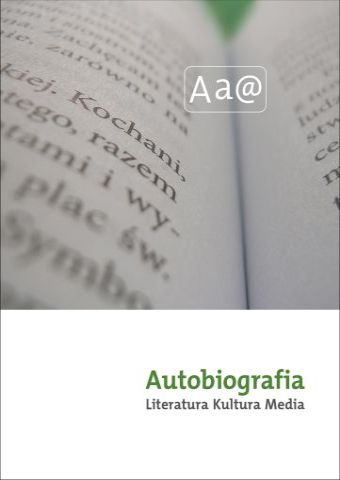






| Authors: |
IZABELLA
ADAMCZEWSKA-BARANOWSKA

Uniwersytet Łódzki |
| Keywords: | autotheory trans memoire subverting the genre |
| Data publikacji całości: | 2022-12 |
| Page range: | 13 (111-123) |
| 1. | Ames, Jonathan. „Introduction”. W: Sexual Metamorphosis. An Anthology of Transsexual Memoirs, red. Jonathan Ames. New York: Vintage Books, 2004 [ebook]. |
| 2. | Barthes, Roland. Roland Barthes. Tłum. Tomasz Swoboda. Gdańsk: słowo / obraz terytoria, 2011. |
| 3. | Bornstein, Kate. Gender Outlaw. On Men, Women, and the Rest of Us. New York: Routledge, 1994. |
| 4. | Catherwood, Rhiannon, „Coming In? The Evolution of the Transsexual Memoir in the Twenty-First Century”. Genre 48 (2015): 35–71. |
| 5. | Clare, Ralph. „Becoming Autotheory”. Arizona Quarterly. A Journal of American Literature, Culture, and Theory 76 (2020): 85–107. |
| 6. | Cossey, Caroline. My Story. London: Faber & Faber, 1991. |
| 7. | Czermińska, Małgorzata. Autobiograficzny trójkąt. Świadectwo, wyznanie, wyzwanie, wyd. 2, zmie¬nione. Kraków: Universitas, 2020. |
| 8. | Esposito, Veronica. Beyond the Trans Memoir. Juliet Jacques on Life After Transition – and Publica¬tion. Dostęp: 2.01.2022. https://lithub.com/beyond-the-trans-memoir/. |
| 9. | Faludi, Susan. W ciemni. Tłum. Joanna Bednarek. Warszawa: Wydawnictwo Krytyki Politycznej, 2017. |
| 10. | Freeman, Elizabeth. Time Binds. Queer Temporalities, Queer Histories (Durham–London: Duke University Press, 2010) |
| 11. | Grodzka, Anna. Mam na imię Ania. Warszawa: Foksal, 2013. |
| 12. | Halberstam, Jack [Judith]. In a Queer Time and Place. Transgender Bodies, Subcultural Lives. New York–London: New York University Press, 2005. |
| 13. | Halberstam, Jack. Przedziwna sztuka porażki. Tłum. Mikołaj Denderski. Warszawa: Wydawnictwo Krytyki Politycznej, 2018. |
| 14. | Horvat, Ana, Lael Netzer, Orly, McRae, Sarah, Rak, Julie. Trans Narratives/ Trans, Transmedia, Transnational. Oxon – New York: Routledge, 2022. |
| 15. | Iwasiów, Inga. „Humanistyka, zmiana, autobiografia. Studium przypadku osobistego”. Acta Uni¬versitatis Lodziensis. Folia Litteraria Polonica 60 (2021): 15–31. |
| 16. | Izdebska, Agnieszka. „«W ciemni» Susan Faludi – opowieść o wyprawie do «pomiędzy»”, Biało¬stockie Studia Literaturoznawcze 15 (2019): 61–76. |
| 17. | Jacques, Juliet. Beyond the Trans Memoir. Dostęp 3.02.2022. https://lithub.com/beyond-the-trans¬-memoir/. |
| 18. | Jacgues, Juliet. Trans. A Memoir. New York: Verso, 2015. |
| 19. | Jorgensen, Christine. A Personal Autobiography. New York: Bantam Books, 1967. |
| 20. | Kosińska, Kinga. Brudny róż. Zapiski z życia, którego nie było. Warszawa: Nisza, 2015. |
| 21. | Łapińska, Joanna. „Testo Junkie Paula B. Preciado jako autobiograficzny «esej cielesny»”. The Polish Journal of Aestetics 50 (2018): 45–55. |
| 22. | Man into Woman. An Authentic Record of a Change of Sex. The True Story of the Miraculous Transfor¬mation of the Danish Painter Einar Wegener (Andreas Sparre). Red. Niels Hoyer, tłum. H.J. Sten¬ning. New York: E.P. Dutton & Company, 1933. |
| 23. | Morris, Jan. Conundrum. New York: Harcourt Brace Jovanovich, 1974. |
| 24. | Nelson, Maggie. Argonauci. Tłum. Kaja Gucio. Wołowiec: Czarne, 2020. |
| 25. | Pellegrini, Chiara. „Posttranssexual Temporalities. Negotiating Canonical Memoir Narratives in Kate Bornstein’s Gender Outlaw and Juliet Jacques’s Trans”. a/b. Auto/Biography Studie 1 (2019): 45–65. |
| 26. | Preciado, Paul B. Testo ćpun. Seks, narkotyki i polityka w epoce farmakopornografii. Tłum. Sławomir Królak. Warszawa: Wydawnictwo Krytyki Politycznej, 2021. |
| 27. | Prosser, Jay. Second Skins. The Body Narratives of Transsexuality. New York: Columbia University Press, 1998. |
| 28. | Richards, Renée, Ames, John. Second Serve. New York: Stein and Day, 1983. |
| 29. | Ronduda, Łukasz. Strategie subwersywne w sztukach medialnych. Kraków: Rabid, 2006. |
| 30. | Serano, Julia. Whipping Girl. A Transsexual Woman on Sexism and the Scapegoating of Feminity. New York: Seal Press, 2016 [ebook]. |
| 31. | Strzelec, Ada. Byłam mężczyzną. Warszawa: Dom Wydawniczy Szczepan Szymański, 1992. |
| 32. | Szcześniak, Magda. „Queerowanie historii, czyli dlaczego współcześni geje nie są niczyimi dziećmi”. Teksty Drugie 5 (2005): 205–223. |
| 33. | Szpilka, Jan. „Śmieciowiska gniewu. Temporalność doświadczenia transpłciowego punku”, Kon¬teksty. Polska Sztuka Ludowa 74 (2020): 217–218. |
| 34. | Yagoda, Ben. Memoir. A History. New York: Penguin Group, 2009. |
| 35. | Vincent, Norah. Self-Made Man. One Woman’s Year Disguised as a Man. New York: Ballantine Books, 2006. |
| 36. | Zamojski, Daniel. Aleksandra Zamojska jest mężczyzną. Lamba: Warszawa, 2005. |